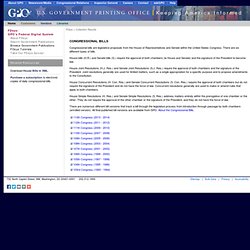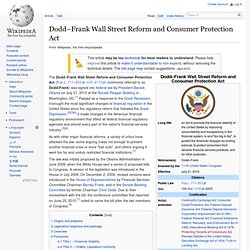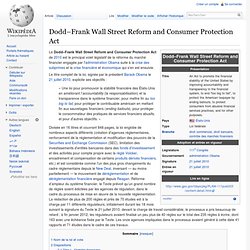

The Durbin Amendment Explained. The Durbin Amendment, a last-minute addition to the Dodd-Frank Wall Street Reform and Consumer Protection Act of 2010, has sparked fierce debate about government regulation, consumer choice, innovation and entrepreneurship.

The bill drastically lowers swipe fees – the fee charged to merchants every time a customer pays with plastic – on debit cards issued by big banks, cutting into the banks’ revenue while, presumably, lowering costs for merchants and therefore consumers. Though the Durbin interchange amendment only began to take effect on October 1st, 2011, we’re already seeing its ramifications. Banks have priced lower swipe fees into their checking offerings – that means we’re seeing less and less free or rewards checking. And since prepaid debit cards aren’t covered by Durbin, we’re seeing an explosion of those products. On the other hand, retailers have yet to lower their prices as promised, perhaps because Visa and MasterCard jacked up their rates on small merchants. Contents. Banks Should Love the Fed's Durbin Amendment Ruling. Financial services regulatory. Dodd-Frank, consumer finance and banking regulations. Www.pwc.com/en_US/us/financial-services/regulatory-services/publications/assets/closer-look-volcker-covered-funds.pdf.
View 13: Understanding the Dodd-Frank Act. In July 2010, President Obama signed the Wall Street Reform and Consumer Protection Act, also known as the Dodd-Frank Act.

The reforms resulting from the act will certainly have an impact on both financial services and nonfinancial services companies across the United States. Touted as a bill that will completely overhaul the financial regulatory system, the Dodd-Frank Act creates new regulators, regulates new markets, brings new firms into the regulatory arena, and provides new rule-making and enforcement powers for existing agencies. While comprehensive in its coverage, the act stipulates many specifics whose implementation has been left in the hands of both existing financial services industry regulators, such as the US Securities and Exchange Commission (SEC) and the Federal Reserve, and newly created ones, such as the Financial Stability Oversight Council and the Consumer Financial Protection Bureau.
The new financial regulatory architecture. Banking.senate.gov/public/_files/070110_Dodd_Frank_Wall_Street_Reform_comprehensive_summary_Final.pdf. Essentials for adapting to the Dodd-Frank Act. Www.ey.com/Publication/vwLUAssets/Dodd_Frank_OTC_derivatives_article_FINAL/$FILE/Dodd_Frank_OTC_derivatives_article FINAL.pdf. Www.ey.com/Publication/vwLUAssets/Positioning_for_change-US_financial_reform_six_months_later/$FILE/Positioning-for-change.pdf. 111th Congress (2009 - 2010) - H.R.4173. Browse BILLS. Congressional Bills Congressional bills are legislative proposals from the House of Representatives and Senate within the United States Congress.

There are six different types of bills. House bills (H.R.) and Senate bills (S.) require the approval of both chambers (ie House and Senate) and the signature of the President to become law. House Joint Resolutions (H.J. Www.davispolk.com/files/Publication/7084f9fe-6580-413b-b870-b7c025ed2ecf/Presentation/PublicationAttachment/1d4495c7-0be0-4e9a-ba77-f786fb90464a/070910_Financial_Reform_Summary.pdf.
Dodd–Frank Wall Street Reform and Consumer Protection Act. The Dodd–Frank Wall Street Reform and Consumer Protection Act (Pub.L. 111–203, H.R. 4173; commonly referred to as Dodd-Frank) was signed into federal law by President Barack Obama on July 21, 2010 at the Ronald Reagan Building in Washington, DC.[1] Passed as a response to the Great Recession, it brought the most significant changes to financial regulation in the United States since the regulatory reform that followed the Great Depression.[2][3][4] It made changes in the American financial regulatory environment that affect all federal financial regulatory agencies and almost every part of the nation's financial services industry.[5][6] As with other major financial reforms, a variety of critics have attacked the law, some arguing it was not enough to prevent another financial crisis or more "bail outs", and others arguing it went too far and unduly restricted financial institutions.[7] Origins and proposal[edit] Share in GDP of U.S. financial sector since 1860[9] Overview[edit] Duties[edit]

Dodd–Frank Wall Street Reform and Consumer Protection Act. Un article de Wikipédia, l'encyclopédie libre.

Le Dodd–Frank Wall Street Reform and Consumer Protection Act de 2010 est le principal volet législatif de la réforme du marché financier engagée par l'administration Obama suite à la crise des subprimes et la crise financière et économique qui s'en est ensuivie. Le titre complet de la loi, signée par le président Barack Obama le , explicite ses objectifs : « Une loi pour promouvoir la stabilité financière des États-Unis en améliorant l'accountability (la responsabilisation) et la transparence dans le système financier, pour mettre fin au too big to fail, pour protéger le contribuable américain en mettant fin aux sauvetages financiers (ending bailouts), pour protéger le consommateur des pratiques de services financiers abusifs, et pour d'autres objectifs. »